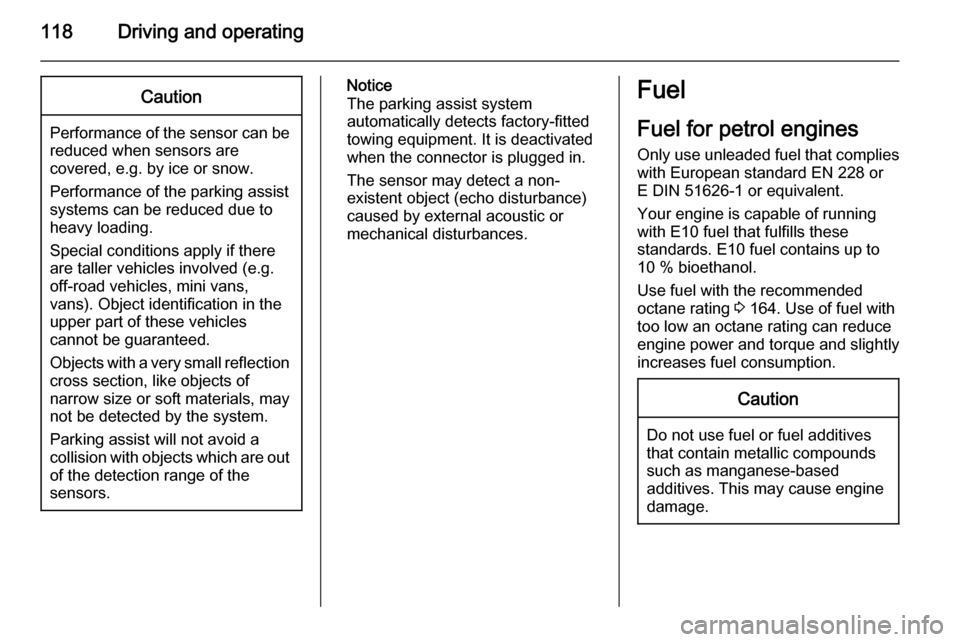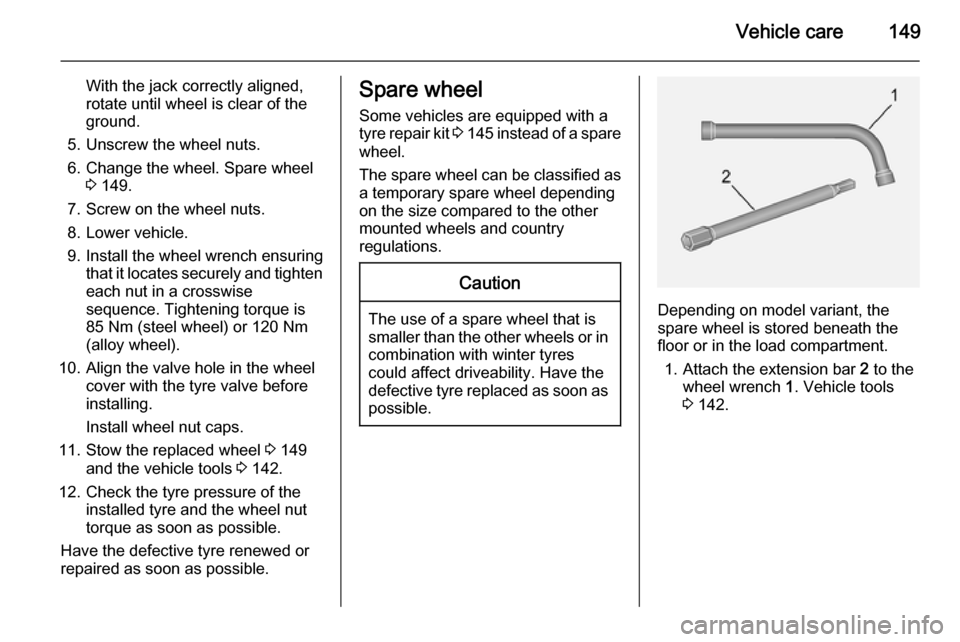torque VAUXHALL COMBO 2014 Owner's Manual
[x] Cancel search | Manufacturer: VAUXHALL, Model Year: 2014, Model line: COMBO, Model: VAUXHALL COMBO 2014Pages: 187, PDF Size: 4.15 MB
Page 105 of 187

Driving and operating103
Turbo engine warm-upUpon start-up, engine available
torque may be limited for a short time, especially when the engine
temperature is cold. The limitation is
to allow the lubrication system to fully
protect the engine.
Vehicle shutdown Fuel cut-off system
In the event of a collision of a certain
severity, the fuel system is cut-off and
the engine is switched off
automatically, for safety reasons. A
corresponding warning message may
also appear in the Driver Information
Centre 3 79.
Notice
In addition, the vehicle is
automatically unlocked and the
interior lights are illuminated.
Turn the ignition key to position
STOP to prevent battery discharge
and seek the assistance of a
workshop immediately. Have thevehicle checked for fuel leaks in the
engine compartment, beneath the
vehicle and near the fuel tank.
To reset the fuel cut-off system and
enable the vehicle to be driven:
1. Turn the ignition key to position MAR 3 102
2. Fully actuate the right turn signal light 3 90
3. Deactivate the right turn signal light
4. Fully actuate the left turn signal light
5. Deactivate the left turn signal light
6. Repeat steps 2, 3, 4 and 5.
7. Turn the ignition key to position STOP .9Danger
If you can smell fuel in the vehicle,
or a fuel leak is present, have thecause of this remedied
immediately by a workshop. Do
not reset the fuel cut-off system, to avoid the risk of fire.
Fuel system messages 3 85.
Overrun cut-off
The fuel supply is automatically cut-
off during overrun, i.e. when the
vehicle is driven with a gear engaged but accelerator is released.
Stop-start system The stop-start system helps to save
fuel and to reduce exhaust emissions.
When conditions allow, it switches off the engine as soon as the vehicle is
at a low speed or at a standstill, e.g.
at a traffic light or in a traffic jam. It
starts the engine automatically as
soon as the clutch is depressed.
A battery sensor ensures that an
Autostop is only performed if the
battery is sufficiently charged for a
restart.
Page 120 of 187

118Driving and operatingCaution
Performance of the sensor can bereduced when sensors are
covered, e.g. by ice or snow.
Performance of the parking assist
systems can be reduced due to
heavy loading.
Special conditions apply if there
are taller vehicles involved (e.g.
off-road vehicles, mini vans,
vans). Object identification in the upper part of these vehicles
cannot be guaranteed.
Objects with a very small reflection
cross section, like objects of
narrow size or soft materials, may
not be detected by the system.
Parking assist will not avoid a
collision with objects which are out
of the detection range of the
sensors.
Notice
The parking assist system
automatically detects factory-fitted
towing equipment. It is deactivated
when the connector is plugged in.
The sensor may detect a non-
existent object (echo disturbance)
caused by external acoustic or
mechanical disturbances.Fuel
Fuel for petrol engines Only use unleaded fuel that complies
with European standard EN 228 or
E DIN 51626-1 or equivalent.
Your engine is capable of running
with E10 fuel that fulfills these
standards. E10 fuel contains up to
10 % bioethanol.
Use fuel with the recommended
octane rating 3 164. Use of fuel with
too low an octane rating can reduce
engine power and torque and slightly increases fuel consumption.Caution
Do not use fuel or fuel additives
that contain metallic compounds
such as manganese-based
additives. This may cause engine
damage.
Page 122 of 187

120Driving and operating
indicator Y illuminates in the Driver
Information Centre 3 79 until the
ignition is switched off.
A slight loss of power and torque can be expected in petrol operation. You
must therefore adapt your driving style (e.g. during overtaking
manoeuvres) and vehicle loads (e.g.
towing loads) accordingly.
Every six months run the petrol tank
down until control indicator §
illuminates and then refuel. This is
necessary to maintain fuel quality as
well as system function necessary for
petrol operation.
Fill the tank completely at regular
intervals to prevent corrosion in the
tank.
Refuelling
Fuel filler flap is located at left rear
side of vehicle.9 Danger
Before refuelling, switch off engine
and any external heaters with
combustion chambers. Switch off
any mobile phones.
Follow the operating and safety
instructions of the filling station
when refuelling.
9 Danger
Fuel is flammable and explosive.
No smoking. No naked flames or
sparks.
If you can smell fuel in your
vehicle, have the cause of this
remedied immediately by a
workshop.
Caution
In case of misfuelling, do not
switch on ignition.
Release the fuel filler flap by pulling
the flap by hand.
Insert key into fuel filler cap and turn
anticlockwise to unlock.
To remove fuel filler cap, rotate
anticlockwise.Caution
To avoid damage, do not attempt
to operate the sliding side door
when the fuel filler flap is open.
Notice
Depending on model, the sliding
side door may be fitted with a safety system that prevents the door from
being opened fully when the fuel
filler flap is open.
Sliding side door 3 23.
Page 151 of 187

Vehicle care149
With the jack correctly aligned,
rotate until wheel is clear of the
ground.
5. Unscrew the wheel nuts. 6. Change the wheel. Spare wheel 3 149.
7. Screw on the wheel nuts.
8. Lower vehicle.
9. Install the wheel wrench ensuring that it locates securely and tighten
each nut in a crosswise
sequence. Tightening torque is
85 Nm (steel wheel) or 120 Nm
(alloy wheel).
10. Align the valve hole in the wheel cover with the tyre valve before
installing.
Install wheel nut caps.
11. Stow the replaced wheel 3 149
and the vehicle tools 3 142.
12. Check the tyre pressure of the installed tyre and the wheel nut
torque as soon as possible.
Have the defective tyre renewed or
repaired as soon as possible.Spare wheel
Some vehicles are equipped with a
tyre repair kit 3 145 instead of a spare
wheel.
The spare wheel can be classified as
a temporary spare wheel depending
on the size compared to the other
mounted wheels and country
regulations.Caution
The use of a spare wheel that is smaller than the other wheels or in combination with winter tyres
could affect driveability. Have the defective tyre replaced as soon as
possible.Depending on model variant, the
spare wheel is stored beneath the
floor or in the load compartment.
1. Attach the extension bar 2 to the
wheel wrench 1. Vehicle tools
3 142.
Page 166 of 187
![VAUXHALL COMBO 2014 Owners Manual 164Technical dataEngine dataSales designation1.41.41.4Engine identifier code1.4i1.4Turbo1.4CNGNumber of cylinders444Piston displacement [cm3
]136813681368Engine power [kW]708888at rpm600050005000Torqu VAUXHALL COMBO 2014 Owners Manual 164Technical dataEngine dataSales designation1.41.41.4Engine identifier code1.4i1.4Turbo1.4CNGNumber of cylinders444Piston displacement [cm3
]136813681368Engine power [kW]708888at rpm600050005000Torqu](/img/38/19395/w960_19395-165.png)
164Technical dataEngine dataSales designation1.41.41.4Engine identifier code1.4i1.4Turbo1.4CNGNumber of cylinders444Piston displacement [cm3
]136813681368Engine power [kW]708888at rpm600050005000Torque [Nm]127206206at rpm450030003000Fuel typePetrolPetrolCompressed Natural Gas/PetrolOctane rating RONrecommended959595possible989898possible919191Gas––CNGOil consumption [l/1000 km]0.60.60.6
Page 167 of 187
![VAUXHALL COMBO 2014 Owners Manual Technical data165
Sales designation1.3 Turbo1.6 Turbo2.0 TurboEngine identifier code1.3CDTI1.6CDTI1)2.0CDTINumber of cylinders444Piston displacement [cm 3
]124815981956Engine power [kW]6666 / 7799at r VAUXHALL COMBO 2014 Owners Manual Technical data165
Sales designation1.3 Turbo1.6 Turbo2.0 TurboEngine identifier code1.3CDTI1.6CDTI1)2.0CDTINumber of cylinders444Piston displacement [cm 3
]124815981956Engine power [kW]6666 / 7799at r](/img/38/19395/w960_19395-166.png)
Technical data165
Sales designation1.3 Turbo1.6 Turbo2.0 TurboEngine identifier code1.3CDTI1.6CDTI1)2.0CDTINumber of cylinders444Piston displacement [cm 3
]124815981956Engine power [kW]6666 / 7799at rpm400040003500Torque [Nm]200200 2)
/ 290320at rpm150015001500Fuel typeDieselDieselDieselOil consumption [l/1000 km]0.60.60.61) Low / High output.
2) Vehicles with manual transmission automated (MTA).